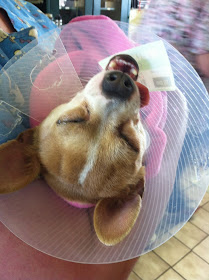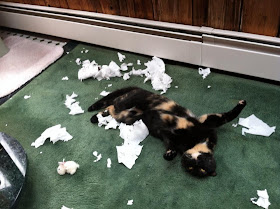When our dog's age their bodies change. These changes can affect their ability to function and co-exist with us.
Here is my dog Savannah's growing old challenges.
She is now 17.
She is a beagle, she is stubborn, she has always been happy, and life has always been on her terms, keys no doubt to longevity. But the years have worn her body down, made her mind foggy, and dulled her senses. I first noticed that she was having some difficulty about four years ago.
One of the first things that I saw was her having difficulty hearing me. I would yell and clap and still she wouldn't recognize that I was calling for her. In the beginning I am sure that I looked like a crazy woman standing a few feet away from her clapping my hands violently and screaming loudly while she just stood there oblivious. Now her hearing has diminished so much that I have to tap her to get her to know where I am. To try not to spook her I will lightly touch her and then clap, or let her sniff my hand, so that she knows who and where I am. Luckily, she is only about 20 pounds so most of the time I just pick her up and carry her to wherever we are going.
Many older dogs do not hear very well. There have been a few studies to identify why, but overall it seems that the very delicate parts of the ear age and change and this causes a decreased sensitivity to sounds.
Her eyesight has also gotten foggy. Just like so many of us aging and needing to pick up glasses to read at 40, our dogs lenses change too. The lens is dynamic device that lets us change our focus. As the lens gets older it can't change shape as fluidly. So we need glasses to compensate. Our dogs, well, they need glasses and a walking stick. Dogs have a harder time seeing in low light situations. For this reason keep lights on, be careful heading outside at dusk and dawn, and give them a very well lit path at every step. Lastly, don't leave them outside alone. They have a very difficult time navigating if they can't hear or see well.
For Savannah we made her world much smaller and much safer. I have baby gates blocking doorways so she can't wander outside of the kitchen and living room. If they aren't up she wanders aimlessly through the house until she gets stranded or stuck somewhere, (most often wedged under the kitchen butchers block). Outside she gets clipped to her 20 foot lead in the front yard. We also dress her in a bright orange sweater with a light and a huge reflective strip around the collar. She may not be able to see well, but we see her!
 |
| A pet/baby gate to let the puppies have access to the front yard, but keep Savannah safely inside. |
She has also gotten a bit feeble at her advanced age. She slips on the floors, especially wood and linoleum, and will sink into a sit if she has to stand for too long. She has her best footing in grass. The soft ground and grass are the easiest footing and encouraging outside time has helped to keep her mobile and ambulatory. The big struggle with an aging body is maintaining muscle mass. Savannah was a power packed muscle bound force in her younger years. She used to run anywhere from 3 to 7 miles with me daily. But she had to give up running about 5 years ago. She was unable and unwilling to try to keep up, and was sore the days after. To try to keep as much muscle tone as possible we encourage her to walk with us. She only goes very short distances and we stop if she stops or starts to look over exerted. Inside we keep runner rugs everywhere. Because the wood floors are so treacherous we minimize them in her space. Eating is always on a rug and always under supervision. The younger pups will stare her down and if she walks awake they inhale her food. To avoid this, and allow her ample time to eat, we feed her separately and watch her closely.
Her food is kept interesting, exciting and highly palatable. If she walks away uninterested I will add or supplement snacks, other canned food, or other dry food to keep her eating. I make sure she has an adequate breakfast and dinner daily. Avoid junk food, stick with high quality foods and snacks. (I have a list that I share with my clients, ask your vet for theirs). A word of caution, don't stray too far on the food list. Many older dogs have much more sensitive stomachs, even a little change can be too much for them, and a bout of vomiting or diarrhea can be more difficult and dangerous for them. Savannah has a difficult time eating. Her balance and strength last about 30 seconds, then she collapses into a sit and soon into a laying position. Elevating her food helped her not have to try to maintain her balance in the face of her waning strength.
Some older dogs also suffer from joint disease like osteoarthritis. Ask you vet about your pets joints, how you can identify joint pain, and what to give your pet to help relieve it. I like glucosamine supplements daily and NSAID's are always on hand for the 'tough days."
As our pets age they will need grooming and personal hygiene assistance. For Savannah that includes daily brushing, bi-annual shave downs, more frequent nail trims because she no longer wears them down on her own. I also keep her ears clean and face clean. She requires much more time and attention but she still loves every moment of it.
 |
| The Spring shave-down. She loves it! She has an extra hop in her step after. |
Savannah has begun to look and act lost more often. She will pace or circle for hours at times if I let her. I have learned that this is almost always her trying to tell me that she needs something. I have a long internal check list that I reference when she acts unsettled. Sometimes she can't find her bed, sometimes she can't get into it, sometimes she can't find the water bowl, sometimes she needs more food, to go outside, and sometimes she just wants me.
To try to keep her anxiety to a minimum she has a very small, safe, easy to navigate living space. She stays downstairs with me during my at home times, in my office, or in our bedroom at night.
She never has access to stairs. She cannot see them and she would plummet to the bottom without hesitation or forethought. Stairs went two years ago. We carry her up for bed and down first thing in the morning. The other very helpful tip that we have discovered is crating her. At night we put her in the puppies crate and they are allowed with us in bed, (much to my husbands chagrin). She is able to stretch out in a dark, quiet, safe place and she sleeps more soundly than she ever has. I also can hear her if she wakes and needs something.
Here is another tip we have learned. When Savannah gets up from a nap, (naps are a frequent daily activity) we immediately put her out. She has almost no ability to defecate voluntarily. She will often just start defecating without any sign that she knows she has to. I tell my clients that "there is a reason you can buy adult diapers at the pharmacy." For many of us the ability to know that we have to go becomes a challenge. (There's a hard dose of reality). With this thought, never reprimand your dog for becoming "less housebroken" they should never be punished for something they cannot control. Expect that they will not be able to make it outside and help them by going back to basic puppy housebreaking training, without the expectation of it working every time. After every meal she is also put out for about twenty minutes. (Dogs usually defecate within twenty minutes of eating).
For more housebreaking tips see; http://kmdvm.blogspot.com/2013/02/housebreaking-your-new-puppy.html
For my older patients I strongly recommend bi-annual (or more often) veterinary visits. We can help you with any of the challenges that aging presents, offer advice, healthy tips, and identify any aging or disease processes early.
Savannah is an old girl, she looks it, she feels it, and she is cared for like it. We have made changes to our home, our lifestyle, and to her care. As she continues to age we will continue to adjust for her.




.JPG)































.jpg)
 Legislative Update AND Invitation!
Legislative Update AND Invitation!











